The global graphite materials market is valued at USD 21,835.3 million in 2025 and is set to reach USD 33,909.5 million by 2035, recording an absolute increase of USD 12,074.2 million over the forecast period. This translates into a total growth of 55.3%, with the market forecast to expand at a compound annual growth rate (CAGR) of 4.5% between 2025 and 2035. The overall market size is expected to grow by approximately 1.6X during the same period, supported by increasing demand from battery manufacturing, expanding electric vehicle production, growing steel industry applications, and rising requirements for advanced carbon materials across energy storage, metallurgy, and industrial processing sectors.
The global graphite materials market represents a critical component within the advanced materials and energy storage industry, driven by the exceptional electrical conductivity, thermal stability, and chemical inertness of graphite compounds. These specialized carbon materials serve as essential components in lithium-ion batteries, steel production processes, refractory applications, and various high-temperature industrial applications. The market encompasses both natural graphite extracted from mining operations and synthetic graphite produced through high-temperature graphitization processes, each offering distinct performance characteristics suited for specific applications.
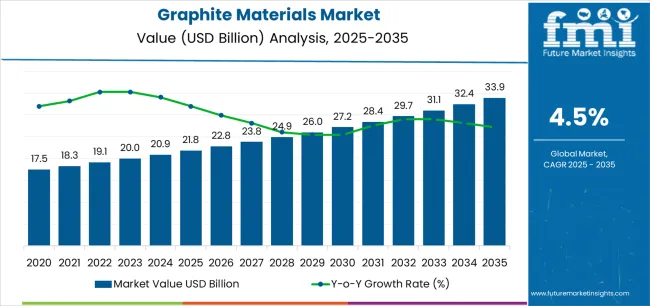
Market dynamics are significantly influenced by the rapid expansion of electric vehicle manufacturing, growing energy storage system deployment, and increasing demand for high-performance battery technologies. The automotive industry's transition toward electrification has created substantial demand for battery-grade graphite materials, particularly in anode applications where graphite serves as the primary active material for lithium-ion batteries. Additionally, the steel industry's continued growth in emerging markets and the increasing adoption of electric arc furnace technology have maintained steady demand for graphite electrodes and refractory materials.
Consumer purchasing patterns show a marked preference for high-purity graphite materials that combine consistent quality specifications with reliable supply chain characteristics. The market has witnessed significant technological advancement in purification processes, particle size optimization, and surface modification techniques, making these materials more suitable for demanding applications in battery manufacturing, semiconductor processing, and specialized industrial applications. Modern graphite processing facilities incorporate advanced beneficiation techniques, thermal purification systems, and quality control measures that can produce materials meeting stringent purity requirements while maintaining cost-effective production economics.
The integration of automated quality control systems, advanced analytical techniques, and process optimization technologies has further enhanced the value proposition of graphite materials among industrial users seeking consistent performance and reliable supply availability. Manufacturing sector emphasis on performance optimization and operational efficiency has created substantial demand for high-performance graphite solutions in battery production, steel manufacturing, and specialized industrial processing applications.
Between 2025 and 2030, the graphite materials market is projected to expand from USD 21,835.3 million to USD 27,210.7 million, resulting in a value increase of USD 5,375.4 million, which represents 44.5% of the total forecast growth for the decade. This phase of development will be shaped by accelerating electric vehicle adoption, rising energy storage system deployment, and growing availability of advanced battery manufacturing technologies across automotive and energy storage applications.
Between 2030 and 2035, the market is forecast to grow from USD 27,210.7 million to USD 33,909.5 million, adding another USD 6,698.8 million, which constitutes 55.5% of the overall ten-year expansion. This period is expected to be characterized by the advancement of next-generation battery technologies, the development of high-capacity energy storage systems, and the expansion of graphite-intensive applications across electric mobility and grid-scale energy storage applications. The growing emphasis on battery performance optimization and energy density enhancement will drive demand for premium graphite varieties with enhanced electrochemical properties, improved particle morphology characteristics, and superior cycling performance profiles.
Between 2020 and 2024, the graphite materials market experienced robust growth, driven by increasing electric vehicle manufacturing and growing recognition of graphite's critical role in battery performance following extensive automotive industry adoption campaigns. The market developed as manufacturers recognized the advantages of high-quality graphite materials over alternative anode materials in lithium-ion applications and began seeking specialized solutions designed for advanced battery performance requirements. Technological advancement in purification techniques and particle engineering began emphasizing the critical importance of maintaining electrochemical performance while enhancing energy density and improving battery life across diverse energy storage applications.
| Metric | Value |
|---|---|
| Estimated Value in (2025E) | USD 21,835.3 million |
| Forecast Value in (2035F) | USD 33,909.5 million |
| Forecast CAGR (2025 to 2035) | 4.5% |
From 2030 to 2035, the market is forecast to grow from USD 27,210.7 million to USD 33,909.5 million, adding another USD 6,698.8 million, which constitutes 55.5% of the overall ten-year expansion. This period is expected to be characterized by the advancement of solid-state battery integration in graphite applications, the integration of artificial intelligence for material optimization, and the development of specialized graphite configurations for next-generation energy storage applications. The growing emphasis on battery performance and material efficiency will drive demand for premium varieties with enhanced electrochemical capabilities, improved manufacturing compatibility, and superior energy density characteristics.
Between 2020 and 2024, the graphite materials market experienced exceptional growth, driven by increasing awareness of battery performance requirements and growing recognition of specialized graphite systems' effectiveness in supporting reliable energy storage operations across automotive and grid-scale applications. The market developed as users recognized the potential for advanced graphite materials to deliver performance advantages while meeting modern requirements for energy density optimization and reliable electrochemical performance. Technological advancement in purification processes and particle engineering began emphasizing the critical importance of maintaining material purity while extending battery life and improving user satisfaction across diverse energy storage applications.
Market expansion is being supported by the increasing global emphasis on electric vehicle adoption and the corresponding shift toward high-performance battery systems that can provide superior energy storage characteristics while meeting user requirements for long-lasting battery performance and cost-effective energy solutions. Modern automotive manufacturers are increasingly focused on incorporating battery systems that can enhance vehicle range while satisfying demands for consistent, reliable energy delivery and optimized charging performance. Graphite materials' proven ability to deliver electrochemical excellence, thermal stability benefits, and diverse application possibilities makes them essential components for battery-focused manufacturers and sustainability-focused automotive professionals.
The growing emphasis on energy storage optimization and battery technology advancement is driving demand for high-performance graphite systems that can support distinctive performance outcomes and comprehensive battery management across automotive applications, grid-scale installations, and premium energy storage systems. User preference for materials that combine functional excellence with performance reliability is creating opportunities for innovative implementations in both traditional and emerging battery applications. The rising influence of renewable energy technologies and advanced storage systems is also contributing to increased adoption of specialized graphite solutions that can provide authentic performance benefits and reliable energy storage characteristics.
The market is segmented by type, application, purity grade, particle size, and region. By type, the market is divided into natural graphite, synthetic graphite, and other specialized configurations. Based on application, the market is categorized into consumer battery, automotive battery, energy storage battery, steel production, and others. By purity grade, the market includes high purity, medium purity, and standard purity categories. By particle size, the market encompasses fine particle, medium particle, and coarse particle configurations. Regionally, the market is divided into North America, Europe, Asia Pacific, Latin America, Middle East & Africa, and other regions.
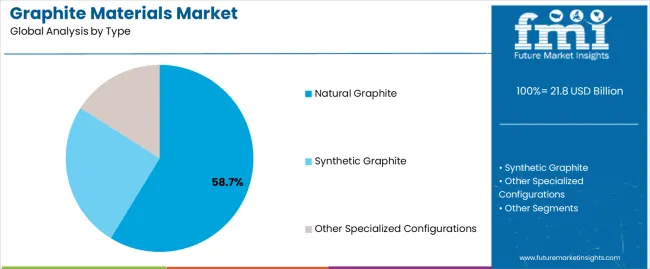
The natural graphite segment is projected to account for 58.7% of the graphite materials market in 2025, reaffirming its position as the leading type category. Industrial users and battery manufacturers increasingly utilize natural graphite systems for their superior cost-effectiveness, established processing standards, and essential functionality in diverse battery applications across multiple energy storage sectors. Natural graphite's proven performance characteristics and established availability directly address user requirements for reliable battery performance and optimal cost optimization in automotive and energy storage applications.
This type segment forms the foundation of modern battery performance patterns, as it represents the material configuration with the greatest application versatility and established compatibility across multiple battery technologies. Industrial investments in advanced processing technology and performance optimization continue to strengthen adoption among battery-focused users. With manufacturers prioritizing cost efficiency and performance reliability, natural graphite systems align with both economic objectives and performance requirements, making them the central component of comprehensive energy storage strategies.
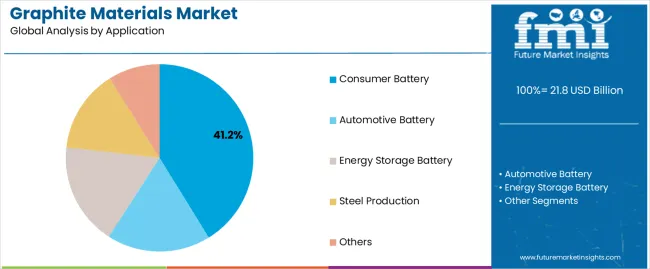
Consumer battery is projected to represent 41.2% of the graphite materials market in 2025, underscoring its critical role as the primary application for battery-focused users seeking superior energy storage benefits and enhanced device performance credentials. Consumer electronics manufacturers and battery producers prefer consumer battery applications for their established performance requirements, proven demand patterns, and ability to maintain exceptional energy density while supporting versatile device coverage during diverse consumer activities. Positioned as essential applications for efficiency-focused manufacturers, consumer battery offerings provide both performance excellence and cost optimization advantages.
The segment is supported by continuous improvement in battery technology and the widespread availability of established consumer electronics standards that enable performance assurance and premium positioning at the device level. Additionally, consumer battery users are optimizing material selections to support device-specific applications and comprehensive battery management strategies. As consumer electronics technology continues to advance and manufacturers seek efficient energy solutions, consumer battery applications will continue to drive market growth while supporting device performance and energy optimization strategies.
The graphite materials market is advancing rapidly due to increasing electric vehicle adoption and growing need for high-performance battery materials that emphasize superior electrochemical performance across automotive segments and energy storage applications. However, the market faces challenges, including supply chain concentration risks, environmental concerns regarding mining operations, and competition from alternative anode materials affecting market positioning. Innovation in purification technology enhancement and advanced processing methods continues to influence market development and expansion patterns.
The growing adoption of graphite materials in electric vehicle battery systems and automotive energy storage integration is enabling manufacturers to develop battery strategies that provide distinctive performance benefits while commanding enhanced energy density and superior driving range characteristics. Electric vehicle applications provide superior cost efficiency while allowing more sophisticated battery optimization features across various automotive categories. Users are increasingly recognizing the performance advantages of specialized graphite positioning for comprehensive vehicle electrification outcomes and battery-integrated automotive management.
Modern graphite material manufacturers are incorporating advanced processing techniques, enhanced purity specifications, and optimized particle characteristics to enhance battery performance, improve energy storage effectiveness, and meet industrial demands for reliable grid-scale energy solutions. These systems improve storage effectiveness while enabling new applications, including renewable energy integration programs and grid stabilization protocols. Advanced processing integration also allows users to support optimal energy positioning and performance assurance beyond traditional battery operation requirements.
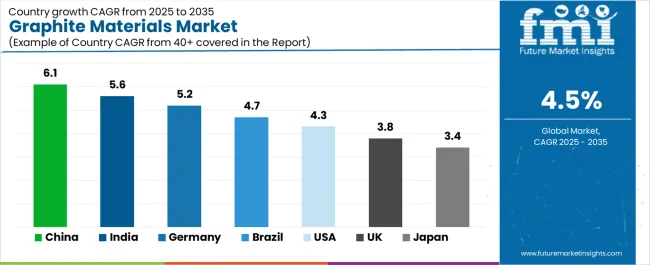
| Country | CAGR (2025-2035) |
|---|---|
| China | 6.1% |
| India | 5.6% |
| Germany | 5.2% |
| Brazil | 4.7% |
| USA | 4.3% |
| UK | 3.8% |
| Japan | 3.4% |
The graphite materials market is experiencing robust growth globally, with China leading at a 6.1% CAGR through 2035, driven by the expanding battery manufacturing sector, growing electric vehicle production requirements, and increasing adoption of advanced energy storage systems. India follows at 5.6%, supported by rising industrial development, expanding steel production industry, and growing acceptance of electric mobility technologies. Germany shows growth at 5.2%, emphasizing established automotive standards and comprehensive battery technology development. Brazil records 4.7%, focusing on industrial modernization and steel industry growth. The USA demonstrates 4.3% growth, prioritizing advanced battery technologies and energy storage optimization.
The report covers an in-depth analysis of 40+ countries, top-performing countries are highlighted below.
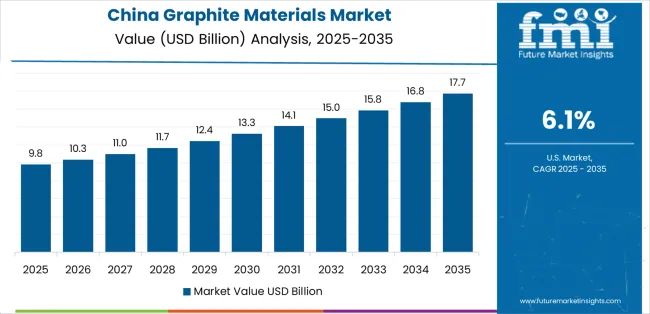
Revenue from graphite materials consumption and sales in China is projected to exhibit exceptional growth with a CAGR of 6.1% through 2035, driven by the country's rapidly expanding battery manufacturing sector, favorable government policies toward electric vehicle adoption, and initiatives promoting energy storage technologies across major industrial regions. China's position as a global battery manufacturing hub and increasing focus on electric mobility systems are creating substantial demand for high-quality graphite materials in both domestic and export markets. Major battery equipment companies and automotive manufacturers are establishing comprehensive graphite capabilities to serve growing demand and emerging electric vehicle opportunities.
Revenue from graphite materials products in India is expanding at a CAGR of 5.6%, supported by rising industrialization investment, growing steel production capabilities, and expanding battery manufacturing consciousness. The country's developing industrial infrastructure and increasing investment in automotive technologies are driving demand for graphite materials across both traditional steel and emerging battery applications. International materials companies and domestic producers are establishing comprehensive operational networks to address growing market demand for carbon materials and efficient industrial solutions.
Revenue from graphite materials products in Germany is projected to grow at a CAGR of 5.2% through 2035, supported by the country's mature automotive standards, established battery technology regulations, and leadership in electric vehicle manufacturing technology. Germany's sophisticated automotive standards and strong support for advanced battery systems are creating steady demand for both traditional and innovative graphite varieties. Leading automotive manufacturers and specialty materials producers are establishing comprehensive operational strategies to serve both domestic markets and growing export opportunities.
Revenue from graphite materials products in Brazil is projected to grow at a CAGR of 4.7% through 2035, driven by the country's emphasis on industrial development, steel production modernization growth, and growing materials distributor capabilities. Brazilian industrial users and manufacturing facilities consistently seek materials-focused equipment that enhances operational efficiency and supports modernization excellence for both traditional steel and modern battery applications. The country's position as a Latin American industrial leader continues to drive innovation in specialized carbon material applications and manufacturing standards.
Revenue from graphite materials products in the USA is projected to grow at a CAGR of 4.3% through 2035, supported by the country's emphasis on battery technology advancement, electric vehicle manufacturing optimization, and advanced energy storage system integration requiring efficient carbon materials. American automotive users and battery-focused facilities prioritize performance reliability and operational precision, making specialized graphite materials essential components for both traditional steel and modern electric vehicle applications. The country's comprehensive automotive technology leadership and advancing electrification patterns support continued market expansion.
Revenue from graphite materials products in the UK is projected to grow at a CAGR of 3.8% through 2035, supported by established industrial standards, mature automotive markets, and emphasis on operational reliability across manufacturing and steel sectors. British industrial users and automotive professionals prioritize quality performance and operational consistency, creating steady demand for premium material solutions. The country's comprehensive market maturity and established industrial practices support continued development in specialized applications.
Revenue from graphite materials products in Japan is projected to grow at a CAGR of 3.4% through 2035, supported by the country's emphasis on precision manufacturing, operational excellence, and advanced technology integration requiring efficient carbon materials. Japanese industrial users and automotive-focused facilities prioritize technical performance and manufacturing precision, making specialized graphite materials essential components for both traditional steel and modern battery applications. The country's comprehensive manufacturing leadership and advancing precision patterns support continued market expansion.
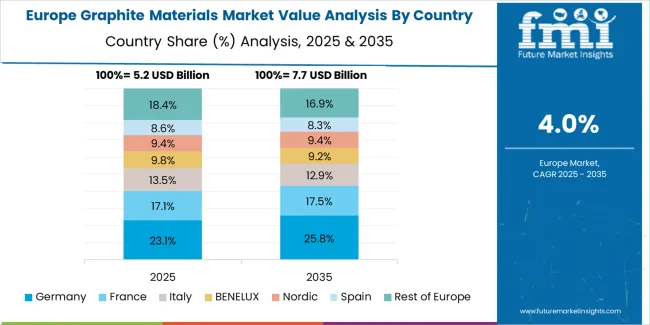
The Europe graphite materials market is projected to grow from USD 6,350.6 million in 2025 to USD 9,581.4 million by 2035, recording a CAGR of 4.2% over the forecast period. Germany leads the region with a 41.8% share in 2025, moderating slightly to 41.3% by 2035, supported by its strong automotive traditions and demand for premium, high-performance graphite solutions. The United Kingdom follows with 22.4% in 2025, easing to 21.9% by 2035, driven by a mature industrial market and emphasis on operational reliability and quality performance. France accounts for 15.2% in 2025, rising to 15.7% by 2035, reflecting steady adoption of automotive technologies and battery optimization.
Italy holds 8.9% in 2025, expanding to 9.6% by 2035 as manufacturing modernization and specialty battery applications grow. Spain contributes 6.1% in 2025, growing to 6.4% by 2035, supported by expanding industrial development and automotive awareness modernization. The Nordic countries rise from 3.4% in 2025 to 3.6% by 2035 on the back of strong engineering consciousness and advanced manufacturing methodologies. BENELUX remains at 2.2% share across both 2025 and 2035, reflecting mature, technology-focused industrial markets.
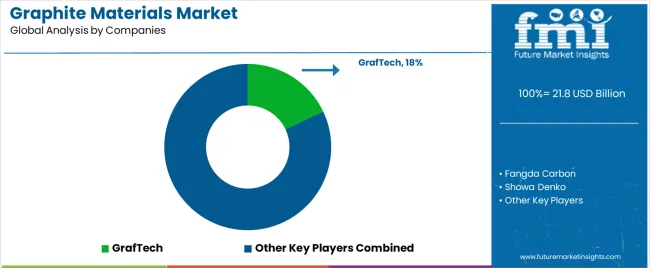
The graphite materials market is characterized by competition among established carbon material manufacturers, specialized graphite producers, and integrated materials providers. Companies are investing in advanced processing technologies, specialized purification engineering, product innovation capabilities, and comprehensive supply chain networks to deliver consistent, high-quality, and reliable graphite material systems. Innovation in purification process optimization, particle engineering advancement, and application-focused product development is central to strengthening market position and customer satisfaction.
GrafTech leads the market with 18% share with a strong focus on carbon technology innovation and comprehensive graphite solutions, offering industrial and battery systems with emphasis on performance excellence and manufacturing heritage. Fangda Carbon provides integrated materials processing with a focus on industrial market applications and precision control networks. Showa Denko delivers comprehensive carbon technology solutions with a focus on battery positioning and operational efficiency. Jilin Carbon specializes in comprehensive natural graphite systems with an emphasis on battery applications. Graphite India focuses on comprehensive industrial materials with advanced processing and premium positioning capabilities.
The success of graphite materials in meeting battery manufacturing demands, automotive efficiency requirements, and industrial integration will not only enhance energy storage performance outcomes but also strengthen global battery technology manufacturing capabilities. It will consolidate emerging regions' positions as hubs for efficient graphite material production and align advanced economies with comprehensive energy storage systems. This calls for a concerted effort by all stakeholders -- governments, industry bodies, manufacturers, distributors, and investors. Each can be a crucial enabler in preparing the market for its next phase of growth.
How Governments Could Spur Local Production and Adoption?
How Industry Bodies Could Support Market Development?
How Distributors and Battery Technology Players Could Strengthen the Ecosystem?
How Manufacturers Could Navigate the Shift?
| Items | Values |
|---|---|
| Quantitative Units (2025) | USD 21,835.3 million |
| Type | Natural Graphite, Synthetic Graphite, Other Specialized Configurations |
| Application | Consumer Battery, Automotive Battery, Energy Storage Battery, Steel Production, Others |
| Purity Grade | High Purity, Medium Purity, Standard Purity |
| Particle Size | Fine Particle, Medium Particle, Coarse Particle |
| Regions Covered | North America, Europe, Asia Pacific, Latin America, Middle East & Africa, Other Regions |
| Countries Covered | China, India, Germany, Brazil, United States, United Kingdom, Japan, and 40+ countries |
| Key Companies Profiled | GrafTech, Fangda Carbon, Showa Denko, Jilin Carbon, Graphite India, and other leading graphite materials companies |
| Additional Attributes | Dollar sales by type, application, purity grade, particle size, and region; regional demand trends, competitive landscape, technological advancements in material engineering, processing optimization initiatives, battery enhancement programs, and premium product development strategies |
The global graphite materials market is estimated to be valued at USD 21.8 billion in 2025.
The market size for the graphite materials market is projected to reach USD 33.9 billion by 2035.
The graphite materials market is expected to grow at a 4.5% CAGR between 2025 and 2035.
The key product types in graphite materials market are natural graphite, synthetic graphite and other specialized configurations.
In terms of application, consumer battery segment to command 41.2% share in the graphite materials market in 2025.






Full Research Suite comprises of:
Market outlook & trends analysis
Interviews & case studies
Strategic recommendations
Vendor profiles & capabilities analysis
5-year forecasts
8 regions and 60+ country-level data splits
Market segment data splits
12 months of continuous data updates
DELIVERED AS:
PDF EXCEL ONLINE
Graphite Market Growth – Trends & Forecast 2025 to 2035
Aerographite Market Size and Share Forecast Outlook 2025 to 2035
Flake Graphite Market
Compacted Graphite Iron Market Size and Share Forecast Outlook 2025 to 2035
Carbon And Graphite Felt Market Size and Share Forecast Outlook 2025 to 2035
Microfined Graphite Powder Market Insights – Size, Trends & Forecast 2025-2035
Nanomaterials Market Insights - Size, Share & Industry Growth 2025 to 2035
Tire Materials Market Insights – Size, Trends & Forecast 2025–2035
Facade Materials Market Size and Share Forecast Outlook 2025 to 2035
Solder Materials Market Size and Share Forecast Outlook 2025 to 2035
Sheath Materials Market Size and Share Forecast Outlook 2025 to 2035
Cathode Materials for Solid State Battery Market Size and Share Forecast Outlook 2025 to 2035
Exosuit Materials Market Size and Share Forecast Outlook 2025 to 2035
Stealth Materials and Coatings Market Size and Share Forecast Outlook 2025 to 2035
Battery Materials Recycling Market Size and Share Forecast Outlook 2025 to 2035
Battery Materials Market: Growth, Trends, and Future Opportunities
Optical Materials Market - Trends & Forecast 2025 to 2035
Circuit Materials Market Analysis based on Substrate, Conducting Material, Outer Layer, Application, and Region: Forecast for 2025 and 2035
Building Materials Market Size and Share Forecast Outlook 2025 to 2035
Recycled Materials Packaging Market Size and Share Forecast Outlook 2025 to 2035

Thank you!
You will receive an email from our Business Development Manager. Please be sure to check your SPAM/JUNK folder too.
Chat With
MaRIA